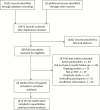Are physical activity interventions for healthy inactive adults effective in promoting behavior change and maintenance, and which behavior change techniques are effective? A systematic review and meta-analysis
- PMID: 29506209
- PMCID: PMC6305562
- DOI: 10.1093/tbm/iby010
Are physical activity interventions for healthy inactive adults effective in promoting behavior change and maintenance, and which behavior change techniques are effective? A systematic review and meta-analysis
Abstract
Physical inactivity and sedentary behavior relate to poor health outcomes independently. Healthy inactive adults are a key target population for prevention. This systematic review and meta-analysis aimed to evaluate the effectiveness of physical activity and/or sedentary behavior interventions, measured postintervention (behavior change) and at follow-up (behavior change maintenance), to identify behavior change techniques (BCT) within, and report on fidelity. Included studies were randomized controlled trials, targeting healthy inactive adults, aiming to change physical activity and/or sedentary behavior, with a minimum postintervention follow-up of 6 months, using 16 databases from 1990. Two reviewers independently coded risk of bias, the "Template for Intervention Description and Replication" (TIDieR) checklist, and BCTs. Twenty-six studies were included; 16 pooled for meta-analysis. Physical activity interventions were effective at changing behavior (d = 0.32, 95% confidence intervals = 0.16-0.48, n = 2,346) and maintaining behavior change after 6 months or more (d = 0.21, 95% confidence intervals = 0.12-0.30, n = 2,190). Sedentary behavior interventions (n = 2) were not effective. At postintervention, physical activity intervention effectiveness was associated with the BCTs "Biofeedback," "Demonstration of the behavior," "Behavior practice/rehearsal," and "Graded tasks." At follow-up, effectiveness was associated with using "Action planning," "Instruction on how to perform the behavior," "Prompts/cues," "Behavior practice/rehearsal," "Graded tasks," and "Self-reward." Fidelity was only documented in one study. Good evidence was found for behavior change maintenance effects in healthy inactive adults, and underlying BCTs. This review provides translational evidence to improve research, intervention design, and service delivery in physical activity interventions, while highlighting the lack of fidelity measurement.
Figures
References
-
- Rhodes RE, Janssen I, Bredin SSD, Warburton DER, Bauman A. Physical activity: Health impact, prevalence, correlates and interventions. Psychol Health. 2017;32(8):942–975. - PubMed
-
- Löllgen H, Böckenhoff A, Knapp G. Physical activity and all-cause mortality: an updated meta-analysis with different intensity categories. Int J Sports Med. 2009;30(3):213–224. - PubMed
-
- The Department of Health. Available at http://www.health.gov.au/internet/main/publishing.nsf/content/health-pub.... Accessibility verified November 13, 2017.
-
- Department for Digital, Culture, Media & Sport. Sporting future – first annual report Available at https://www.gov.uk/government/publications/sporting-future-first-annual-.... Accessibility verified March 9, 2017.
-
- Centre for Disease Control and Prevention. Available at https://www.cdc.gov/physicalactivity/data/facts.htm. Accessibility verified November 13, 2017.
Publication types
MeSH terms
LinkOut - more resources
Full Text Sources
Other Literature Sources
Medical


